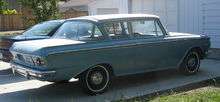Sedan (automobile)
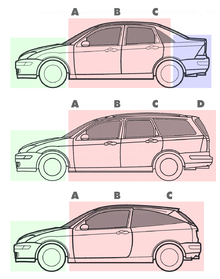
A sedan /sɪˈdæn/ (American, Canadian, Australian, and New Zealand English) or saloon (British, Irish and Indian English) is a passenger car in a three-box configuration with A, B, & C-pillars and principal volumes articulated in separate compartments for engine, passenger and cargo.[1] The passenger compartment features two rows of seats and adequate passenger space in the rear compartment for adult passengers. The cargo compartment is typically in the rear, with the exception of some rear-engined models, such as the Renault Dauphine, Tatra T613, Volkswagen Type 3 and Chevrolet Corvair. It is one of the most common car body styles. A battery electric liftback such as the Tesla Model S has no engine compartment, but a front cargo compartment and a rear compartment for cargo.
Types of sedans
The primary purpose of the sedan is to transport people and their baggage on ordinary roads.[2] Sedan versions of the automobile body style have a central pillar (B-pillar) that supports the roof and come in two- and four-door versions.[3] Sedans usually have a two-box or three-box body.[2]
The shape and position of the automobile greenhouse on both two- and four-door sedans may be identical, with only the center B-pillar positioned further back to accommodate the longer doors on the two-door versions. For example, 1962 Rambler Classic sedans feature identical windshield, A-pillar, roof, C-pillar, and rear window. The two-door sedans have longer doors and include roll down rear side window and even a quarter window that is shaped to follow the reverse slant of the C-pillar, just like on the rear doors of the four-door sedans.[4]
Club sedans
.jpg)
A two- or four-door design built on a normal chassis, but with a shorter roof and interior space, club sedans were most often available in high-level U.S. models from the mid-1920s to the mid-1950s.[5] Originating from the club car on a Pullman passenger train that was well appointed, the "club" term imparted a sense of class to the smaller-cabin versions in the range of models.[5]
Notchback sedans

A notchback sedan is a three-box sedan, where the passenger volume is clearly distinct from the trunk volume of the vehicle (when seen from the side). The roof is on one plane, generally parallel to the ground, the rear window at a sharp angle to the roof, and the trunk lid is also parallel to the ground.
Fastback sedans
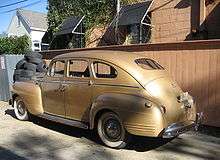
A fastback sedan is a two-box sedan, with continuous slope from the roof to the base of the decklid (trunk lid), but excludes the hatchback feature. Marketing terminology is often misleading in this area - for example, Daimler AG incorrectly calls the Mercedes-Benz CLS-Class sedan a four-door coupé because its semi-fastback design tries to give the impression of a coupé. Certain sedans are edging close to being one-box vehicles, where the windshield is steeply raked from the hood/bonnet and the rear window slopes toward almost the end of the car, leaving just a short rear deck that is part of the trunk lid — the 2006 4-door JDM Honda Civic is an example of this. They are not fastbacks because their bodyline changes from the roof to the rear deck. Their steeply raked rear windows end with a decklid that does not continue down to the bumper. Instead, their rear ends are tall — sometimes in a Kammback style — to increase trunk space.
Typically this design is chosen for its aerodynamic advantages. Automakers can no longer afford the penalty in fuel consumption produced by the traditional notchback three box form.
Hardtop sedans

In historic terminology, a sedan-door will have a frame around the door windows, while the hardtop doors end at the waist line. There is no center or "B" pillar for roof support behind the front doors.[6] This pillarless body style offers greater visibility.[7] However, it requires extra underbody strengthening for structural rigidity. The hardtop design can be considered separately (i.e., a vehicle can be simply called a four-door hardtop), or it can be called a hardtop sedan. During the 1960s and 1970s, hardtop sedans were often sold as sport sedans by several American manufacturers and they were among the top selling body styles. During the 1980s, automakers in the U.S. focused on removing weight and increasing strength, and their new four-door sedans with B-pillars were called pillared hardtops or pillared sedans. The sport sedan term has since been appropriated for other uses. In Japan the hardtop design was used for several luxury-type sedans during the 1990s.
Hatchback sedans
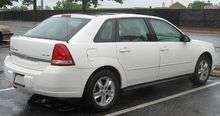
Hatchback (a.k.a. liftback) sedans typically have the fastback profile, but instead of a trunk lid, the entire back of the vehicle lifts up (using a liftgate or hatch). A vehicle with four passenger doors and a liftgate at the rear can be called a four-door hatchback, five-door hatchback, four-door hatchback sedan, or five-door sedan. An example of such is the Chevrolet Malibu Maxx and Audi A5 Sportback. There can also be two-door hatchback sedans (three-door sedans), by the same technical explanation for two-door sedans. Examples of this design are the Ford Focus, Ford Fiesta, Volkswagen Golf, Chevrolet Chevette and Daewoo Nexia (Opel Kadett E).
Chauffeured sedans
.jpg)
Strictly speaking, limousine sedans have a separate compartment for the driver and the passenger compartment is long enough to contain at least two comfortable, forward-facing bench seats. Vehicles used for these means are usually Lincoln Town Car, Cadillac, Mercedes-Benz, or Rolls-Royce.
The term limousine can refer to a large sedan, especially if hired from a service. Chauffeured limousines are primarily used by individuals for weddings, businesses for meetings, as well as for airport and sightseeing transportation. Chauffeurs are professional drivers, usually with experience in the transportation industry or tourism industry. Chauffeured sedans are owned either by private owners, livery services, or corporations. Large corporations as well as governments commonly provide luxury sedans to top executives, as well as VIP guests. Chauffeured sedans, such as the Lincoln Town Car, may also be stretched into limousines that are capable of seating up to twenty people.
Close-coupled sedan
A close-coupled sedan is an obsolete type of car body which disappeared from the United States market by World War II, though it survived elsewhere for a time. It was a four-windowed sedan with a trunk that from front to rear was almost as thin as an upright suitcase. Such a vehicle was a bit lighter, and hence less expensive, than a regular sedan of the day, which had its rear-seat passengers sitting over the differential, and had room for a wider trunk at the rear, sometimes being a compartment added on not at the factory but by specialists. The passengers in a close-coupled sedan sat a little bit forward of the differential, so they had somewhat less room.
The mechanical particular was that the rear suspension could not be a Hotchkiss drive. Ford Motor Company, which used a transverse spring suspension until 1949, could offer such a vehicle, and called its version a "Victoria" in the 1930s.
Sedanets
.jpg)
.jpg)
Haajanen in his Illustrated Dictionary of Automobile Styles considered the name should indicate a small sedan body then adds that it does not appear to have been so[5] but see the last known mention, 1956 Studebaker below.
- 1917 Dort Sedanet: "The Sedanet is an entirely different year 'round car. It is as comfortable as a limousine for bad weather driving — with the plate glass windows and side panels removed it is a handsome touring car.
- Quick acting side curtains are provided for use when necessary."[8]
- In the 1920s other brands with similarly named bodies included King and Lexington.[5]
- For 1930 Cadillac's catalogue included — among the fourteen Fleetwood Special Custom Bodies — their Fleetwind Four-passenger Sedanette Cabriolet and their Fleetwind Four-passenger Sedanette.[9] They may have been convertibles (Fleetwind) with wind-down plate glass side-windows because they were listed immediately after their Phaeton.
- Buick and Cadillac had fully enclosed two-door fastback models they called Sedanets / Sedanettes in the 1940s
- As late as 1956 the Studebaker catalogue included a two-door sedanet (not a fastback) as well as a two-door sedan, the sedanet was shorter.
Terminology
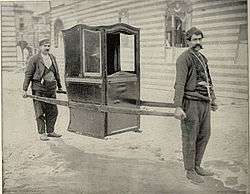
Origin
The word sedan is possibly derived from a southern Italian dialect derivative of Italian sedia "chair" (the first sedan was said to have been introduced from Naples). However, Portuguese and Spanish navigators and colonists encountered litters of various sorts in India, Japan, Mexico, and Peru. They were imported into Spain in the late sixteenth century. Soon the fashion spread into France and then England. All the names for these derived from the root "sed-" from the Latin "sella" - the traditional name for a carried chair.[10]
The Online Etymology Dictionary points to Italian (sedia = chair) & Latin (sedere = sit) origins for the term 'sedan'. Online Etymology Dictionary
The first automobile to use the configuration was the 1899 Renault Voiturette Type B. The first closed car, for at least 4 persons, which used the word sedan was the 1911 Speedwell sedan, which was manufactured by the Speedwell Motor Car Company in Dayton, Ohio.[11] But even before that time completely closed cars were called saloons or limousines, like the 1905 Rational 4-door limousine[12] or the 1907 Renault 4-door limousine[13] or the 1910 Stella 2-door saloon.[14] The words saloon or limousine do not exclusively mean a fully closed car.[15] Cars which are called sedans are almost always fully closed. The term "convertible sedan" was used in the 1930s to describe a car with a soft, foldable top and roll-up windows, very much like a convertible coupe.
The derivation from the town of Sedan, Ardennes in France, where it was said to have been made or first used, lacks historical evidence, according to Oxford English Dictionary.
International terminology
In American English and American Spanish, the term sedan is used (accented as "sedán" in Spanish). The engine compartment, at the front, is covered by the hood; the cargo compartment at the rear is called the trunk.
In British English, a car of this configuration is called a saloon. The engine compartment cover is the bonnet, the cargo-compartment boot is at the rear. Hatchback sedans are known simply as hatchbacks (not hatchback saloons); long-wheelbase luxury saloons may be referred to as limousines. A sports sedan with hatchback rear are typically called hot hatches in UK, but this usage is largely limited to upgraded small cars.
The British English term saloon is sometimes used by British car manufacturers in the United States. For example, the Rolls-Royce Park Ward was sold as a saloon in the United States, while the smaller Silver Seraph was called a sedan.
In Australia and New Zealand the British terms "boot", "bonnet" and "windscreen" are most commonly used, but the American terms are understood by most of the population. However, the American terms "sedan" and "station wagon" are predominantly used, with "saloon" only finding occasional usage, particularly in the field of motor racing. In other languages, sedans are known as berline (French), berlina (European Spanish, European Portuguese, Romanian, and Italian); although these terms also may include hatchbacks. These terms, besides sedan, derive from types of horse-drawn carriages. In German, the term limousine is used for sedans, and "Stretch-Limousine" for limousines.
See also
References
- ↑ "Car Design Glossary - Part 2: One-Box (Monospace or Monovolume)". Car Design News. Archived from the original on 3 December 2013. Retrieved 9 September 2015.
The principal volumes of the traditional sedan can be split into separate compartments or boxes: the hood/bonnet is the first box; the passenger compartment the second, and the trunk/boot the third - i.e. it's a 'three-box' car.
- 1 2 Morello, Lorenzo (2011). The automotive body - Volume I, Components design. Springer. p. 184. ISBN 9789400705128. Retrieved 9 September 2015.
- ↑ Duffy, James (2008). Auto Body Repair Technology (Fifth ed.). Cengage Learning. pp. 27–28. ISBN 9781418073541. Retrieved 9 September 2015.
- ↑ "1962 Rambler Brochure". oldcarbrochures.com. pp. 6–7. Retrieved 9 September 2015.
- 1 2 3 4 Haajanen, Lennart W. (2007). Illustrated Dictionary of Automobile Body Styles. McFarland. p. 43. ISBN 9780786437375. Retrieved 9 September 2015.
- ↑ Thomas, Alfred; Jund, Michael (2009). Collision repair and refinishing: a foundation course for technicians. Cengage Learning. p. 164. ISBN 978-1-4018-8994-4. Retrieved 28 February 2013.
- ↑ "Rambler has everything new - even a hardtop wagon". Popular Mechanics. 105 (1): 116–117. January 1956. Retrieved 28 February 2013.
- ↑ Dort Motor Car Co, Wisconsin Motorist November 1916, H A Apple, publisher, Milwaukee
- ↑ GM Heritage Centre
- ↑ T. Atkinson Jenkins. "Origin of the Word Sedan", Hispanic Review, Vol. 1, No. 3 (Jul., 1933), pp. 240-242.
- ↑ Georgano, G.N. (1985). Cars: Early and Vintage, 1886-1930. London: Grange-Universal. page 87
- ↑ Georgano, G.N.: The Complete Encyclopedia of Motorcars: 1885 to the Present, 2. Ausgabe, E. P. Dutton, New York (1973), page 573, ISBN 0-525-08351-0
- ↑ Georgano, G. N.: The Complete Encyclopedia of Motorcars: 1885 to the Present, 2. Ausgabe, E. P. Dutton, New York (1973), page 578, ISBN 0-525-08351-0
- ↑ Georgano, G.N.: The Complete Encyclopedia of Motorcars: 1885 to the Present, 2. Ausgabe, E. P. Dutton, New York (1973), page 649, ISBN 0-525-08351-0
- ↑ There are many photos of half open limousines and saloons in the book "The Complete Encyclopedia of Motorcars: 1885 to the Present" by Georgano, G.N..
External links

